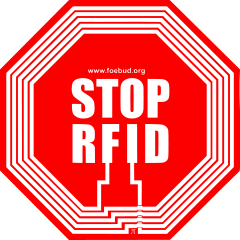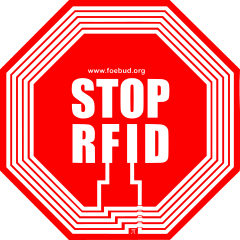
Some may wonder what this is all about. Safety, what for? If someone wants to nap my wallet he will if he’s good, if not he’d better run faster than I do… right? Well let me tell you that a thief doesn’t have to take your wallet any longer to steel what he wants or needs. The person just has to be close enough to retrieve data.
You probably heard of RFID before. There’s a whole lot of information on this  excellent but also worrying technology. If used in the commercial field there’s very little to be concerned about. Unfortunately the RFID chips will not become invalid once the individual item leaves the store and is in your possession. Today we find RFID chips not only in commercial items but also in our wallet. EDL (Enhanced Driver’s Licenses) are issued today and will undoubtedly change your experiences with state officials and officers. Those RFID chips, unlike many others have stronger capacities and their communication range is larger than that of anti-theft devices. For instance, if you’re being pulled over for a traffic control, the RFID chip in your EDL will communicate with the computer in the trooper’s vehicle and the officer will know who you are and see your record. No question this will increase the officers safety. Let’s face it, it will also change their actions and behavior. Picture that… you have a record for smoking pot 5 years ago and didn’t smoke anymore or haven’t had any further record. Now you’re standing in the traffic jam and a cop next to you. His computer tells him that a person with a drug related record is next to him and he thinks it might be worth to control this individual. Do you want to be stopped for no reason by such a cop? On a side not it should be understood that this information is not found on the RFID chip, but linked with the police’ data bases.
excellent but also worrying technology. If used in the commercial field there’s very little to be concerned about. Unfortunately the RFID chips will not become invalid once the individual item leaves the store and is in your possession. Today we find RFID chips not only in commercial items but also in our wallet. EDL (Enhanced Driver’s Licenses) are issued today and will undoubtedly change your experiences with state officials and officers. Those RFID chips, unlike many others have stronger capacities and their communication range is larger than that of anti-theft devices. For instance, if you’re being pulled over for a traffic control, the RFID chip in your EDL will communicate with the computer in the trooper’s vehicle and the officer will know who you are and see your record. No question this will increase the officers safety. Let’s face it, it will also change their actions and behavior. Picture that… you have a record for smoking pot 5 years ago and didn’t smoke anymore or haven’t had any further record. Now you’re standing in the traffic jam and a cop next to you. His computer tells him that a person with a drug related record is next to him and he thinks it might be worth to control this individual. Do you want to be stopped for no reason by such a cop? On a side not it should be understood that this information is not found on the RFID chip, but linked with the police’ data bases.
A simple rule I learned sometime back while in training as a police officer is that what one man creates another man will be able to break.
In an effort to make passports more secure, several countries have implemented RFID in passports.[90] However, the encryption on UK chips was broken in under 48 hours.[91] Since that incident, further efforts have allowed researchers to clone passport data while the passport is being mailed to its owner. Where a criminal used to need to secretly open and then reseal the envelope, now it can be done without detection, adding some degree of insecurity to the passport system.[92]
This alone should provide enough reason to protect your RFID tags/chips in your wallets from external and unwanted access. I hope you get that this, just like any other technology can work in two ways. A good and just one as well as in a bad and illegal way.
Why Use An RFID-Blocking Wallet?
As it stands right now, most credit cards and debit cards issued within the past decade have RFID technology embedded in them. All US passports issued in 2006 and later have RFID chips that track your data and photo. RFID chips are a convenient way to store and read data – instead of having to swipe your card through a reader, you can simply wave your card in front of an RFID scanner without even taking it out of your wallet. It’s convenience at its best.
Unfortunately, the danger is that someone could build a counterfeit reader – which wouldn’t be too difficult for anyone who has experience in that field – and pick up your RFID information against your will. It’s similar to one of the risks in an NFC device, which requires a close-up “bump” to trigger a transaction. Counterfeit card readers existed before RFID, but they require you to physically swipe your card through a slot; counterfeit RFID readers can pull or delete data without so much as you walking by.
I don’t want to hide the other view on RFID safety from you. The author of this article believes that one doesn’t need such a device cause a so called skimmer can only retrieve your name and country of origin etc. Well this is true for one item. Now please take a look in your wallet and tell me what you see. There are various credit cards, and other cards, such as you use for bonus points etc. All this information and a thorough Google search, maybe some facebook reading etc. enables most clever criminals to steel your identity in a hurry. The author of that article didn’t think the whole problem through and concentrated on a very small topic only.
I guess you see where this will lead to and that RFID blocking does make sense. And how is it being done? You will find this information a lot… “Just add aluminium foil…” . I even heard or read from some fellow that the household aluminium foil would offer sufficient protection. Bottom line – this is BS.
Electromagnetic shielding
The shielding effectiveness of aluminium foil depends upon the type of incident field (electric, magnetic, or plane wave), the thickness of the foil, and the frequency (which determines the skin depth). Shielding effectiveness is usually broken down into a reflection loss (the energy bounces off the shield rather than penetrates it) and an absorption loss (the energy is dissipated within the shield).
Although aluminium is non-magnetic, it is a good conductor, so even a thin sheet reflects almost all of an incident electric wave. At frequencies more than 100 MHz, the electric field is attenuated by more than 80 decibels (dB) (less than 10−8 = 0.00000001 of the power gets through).[12]
Thin sheets of aluminium are not very effective at attenuating low-frequency magnetic fields. The shielding effectiveness is dependent upon the skin depth. A field traveling through one skin depth will lose about 63 percent of its energy (it is attenuated to 1/e = 1/2.718… of its original energy). Thin shields also have internal reflections that reduce the shielding effectiveness.[13] For effective shielding from a magnetic field, the shield should be several skin depths thick. Aluminium foil is about 1 mil (25 µm); a thickness of 10 mils (250 µm) (ten times thicker) offers less than 1 dB of shielding at 1 kHz, about 8 dB at 10 kHz, and about 25 dB at 100 kHz.
So just adding aluminium foil doesn’t do the trick. For a list of US approved devices refer to this site http://www.idmanagement.gov/approved-products-list.
Effective shielding really depends on the frequency used by the RFID device. The higher the frequency the more effective will be the shielding with aluminium or copper. The lower the frequency the more resistant is the device to shielding.
Note:
The downturn of shielding is that it will have to be built into the wallet and will add to the thickness of the wallet and may make it a bit stiffer and one may even feel it. To compensate this, one will have to use thinner materials and it will not actually shield the transmission, but rather reduce the distance the transmission can reach and a person will have to come really close. The most effective shield is provided by iron, followed by Mu-metal.
